Looking for Croton plant care tips and tricks? This stunning plant has vibrant, colorful leaves that will brighten any room.
This tropical plant can be a little tricky to master so keep reading and we’ll share everything there is to know to grow these stunning plants.
Table of Contents
Scientific Background
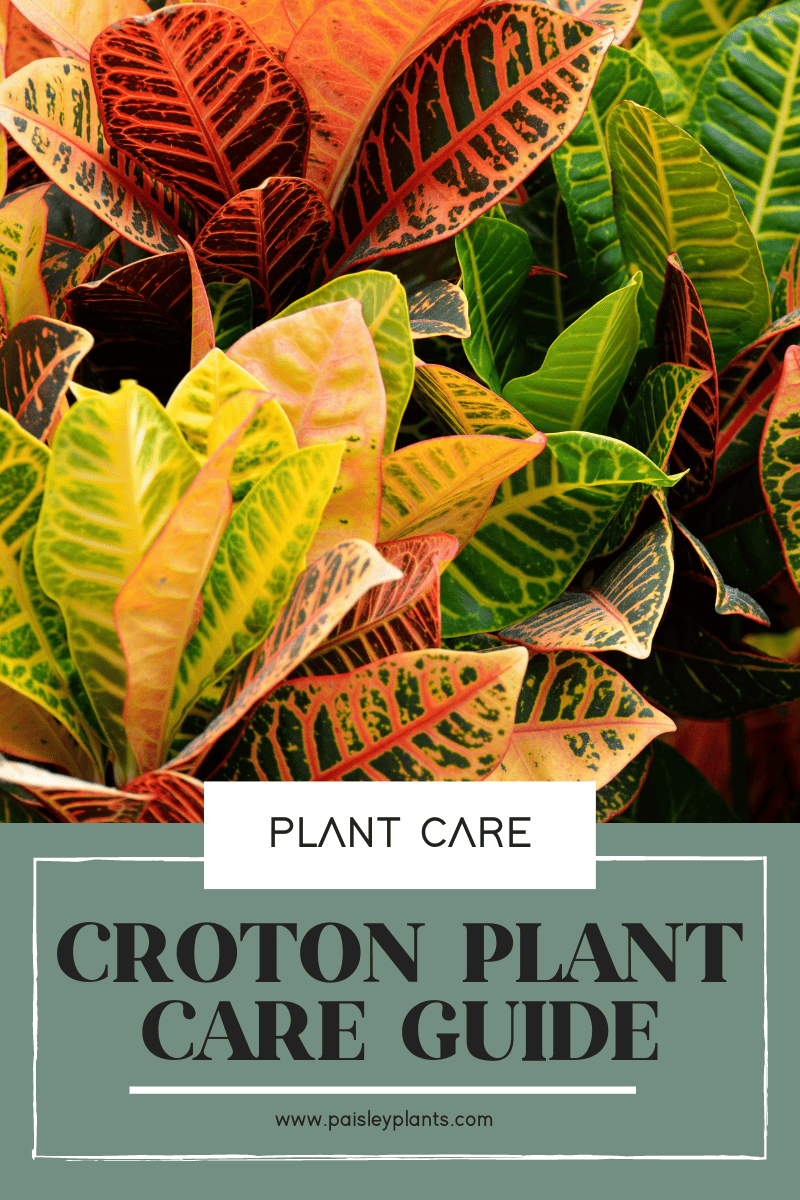
This post includes affiliate links.
The Codiaeum variegatum is native to the regions of tropical Asia and the Pacific Islands. Interesting enough, it is part of the euphorbia family and not the Croton family as one might believe due to it’s common name.
They’re evergreen shrubs and have thick, oval, pointed leaves. Their variegated leaves come in an explosion of vibrant colors which include, red, yellow, orange, and green.
Some of the common names you’ll hear this plant being called is Joseph’s coat, Garden Croton, Puding, Variegated Laurel amongst others.
Crotons are grown both outdoors and indoors. If they are grown outdoors and not in a pot, they grow as branching, bushy shrubs that can grow up to 10 feet tall. Indoor plants grown in a pot pot typically grow to about 3 feet tall.
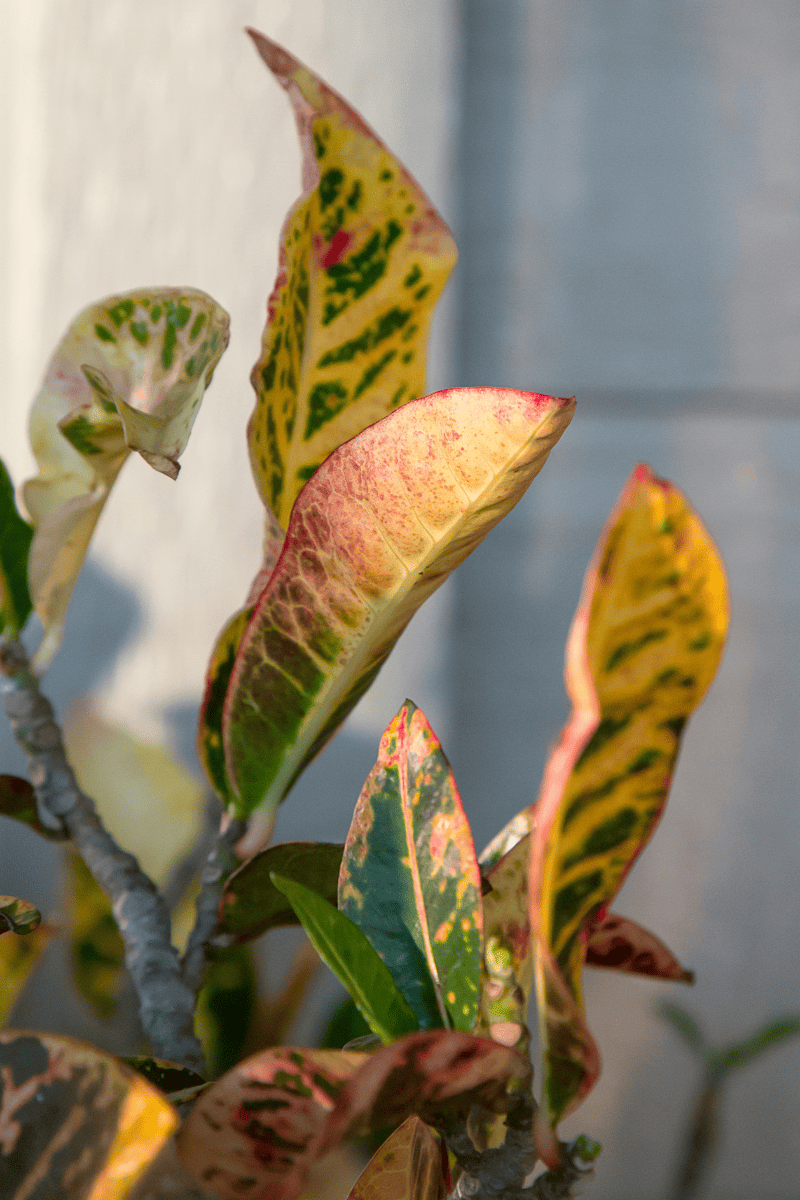
Croton Varieties
There’s a variety of different croton plants. Here’s some of the most popular:
- ‘Andreanum’ – Yellow leaves that are yellow with gold veins.
- ‘Mammy’ (or ‘Mammie’) – Ruffled multi-color leaves that are oftentimes green and purple with splashes of red
- ‘Petra’ – the most common variety of croton plant. It has oval, green leaves with yellow, pink and orange/red hues.
- ‘Gold Star’ – Narrow leaves that are green with yellow spotting
Toxicity
Croton plants are highly toxic to both humans and animals, so keep these far away from children and pets.
Croton Plant Care
Here’s all the croton plant care tips and tricks you need!
Sun & Light
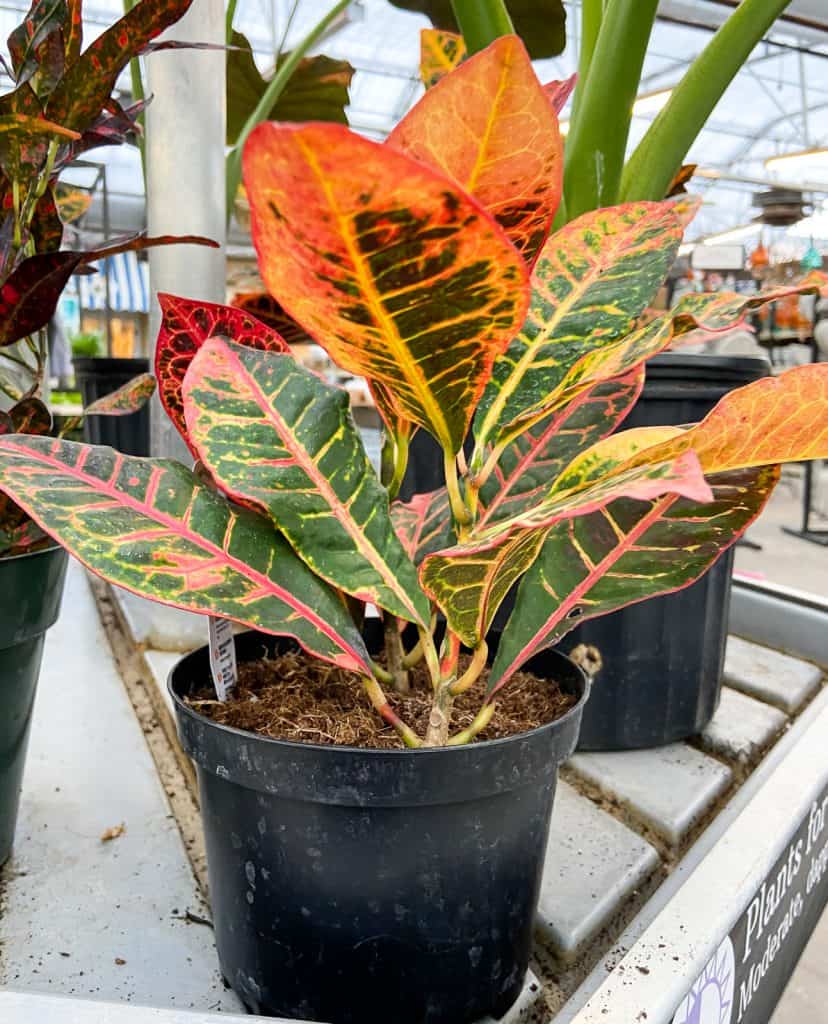
In order to thrive, Crotons need a lot of light! They are used to tropical climates and do best with plenty of bright, indirect sunlight. The more light your croton gets the more vibrant the leaf color will be.
It can tolerate bright light without a lot of shade in cooler climates but keep an eye on it during the hot summer months if it gets full sun. Ideally move it to a spot where it gets partial shade during the warmer months to prevent it’s leaves from turning gray or becoming dull looking.
On the other hand, not enough light will cause the leaves to revert to shades of green and lose it’s bright colors. You’ll know you’ll need to change up the light source and how much light it gets if you see the leaves begin to change colors
Water
The croton plant does best in a nice, moist soil. Because of this, frequent watering is key To know when you need to water it, stick your finger into the top of the soil. If the top half inch to inch of soil is dry, it’s time to water it. If it’s moist, you can wait.
As the winter approaches, reduce your watering to only once every two weeks.
Like the light, your plant will tell you if it is getting too much water. You’ll start to notice leaf drop if you’re overwatering it or under-watering it.
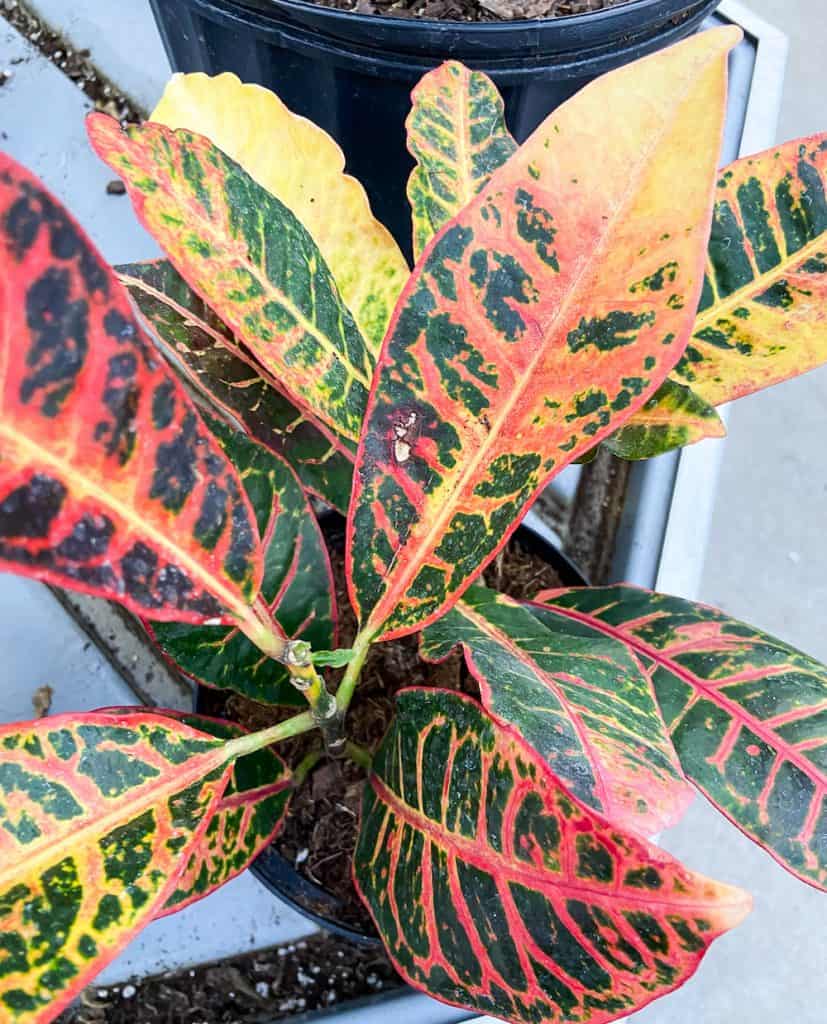
Soil
When choosing a soil for your new plant, choose something that is well-draining, yet moist. The soil should be rich with organic compost and humus. Crotons enjoy an acidic soil type, aim for a pH level between 4.5 and 6.5.
Fertilizer
For fertilizing your croton, you have two options. The first is using slow-release pellets three times per year. These times are during the early spring, the middle of summer, and the beginning of fall.
Your other option is to use a liquid fertilizer once a month between March and September. With both of these options, never fertilize during the winter. The ideal NPK ratio for fertilizer is either a 3-1-2 or a 8-2-10.

Temperature & Humidity
Your croton loves warm temperatures and a humid environment, even in the winter months! They are, after all tropical plants. Do your best to ensure the room temperature never dips below 60°F. Most standard home temperatures will do just fine but keep them away from drafty windows or doors or air conditioning vents.
Just like these plants love lots of light, the love high humidity! For best results, the humidity level in your home should be between 40 and 80%. If you notice leaves falling off that’s a good sign of too low humidity.
Using an air humidifier can help you maintain a proper humidity level in your home. You can also try a pebble tray under the plant or near the plant to help try to increase humidity levels.
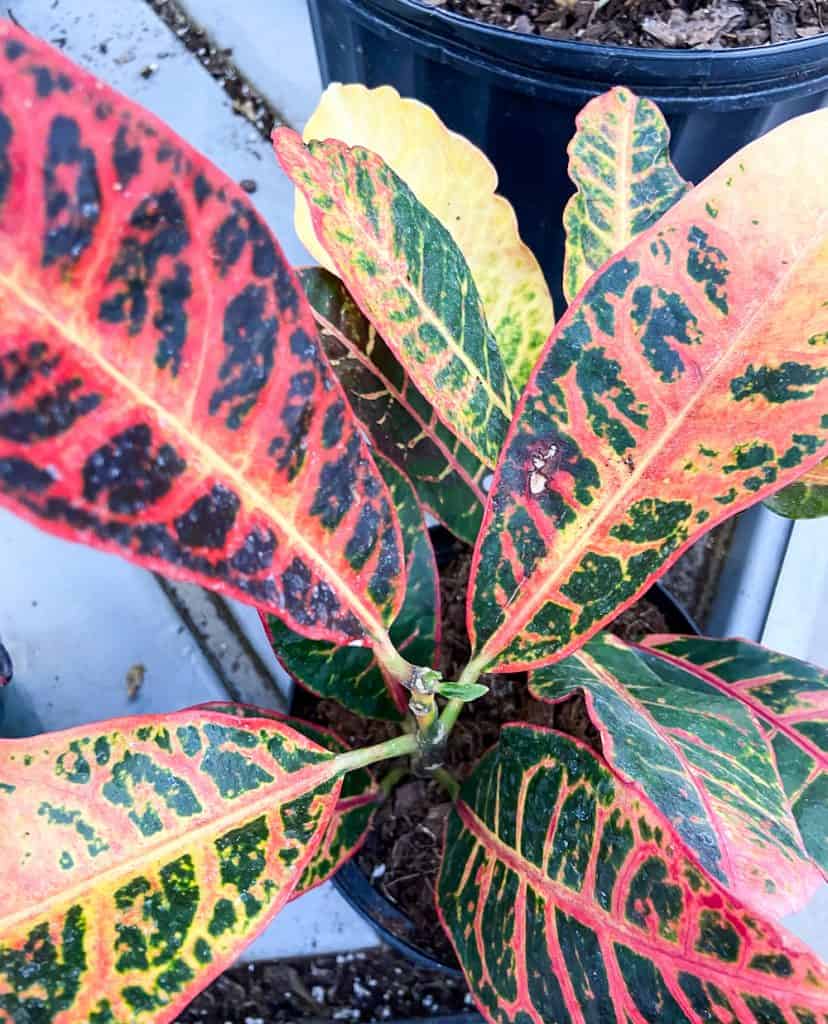
Choosing a Pot & Repotting
One important thing to remember when choosing a pot for your croton is to ensure it has a drainage hole or two to allow excess water escape from the bottom of the pot. This will help prevent the roots from sitting in standing water which can cause issues like root rot.
If you purchase your croton from a plant nursery, you’ll only need to repot it in a container that is 1 to 2 inches larger than the container you purchased it in.
If you’re starting with a young croton, you should repot it every year in the spring or summer for the first three years. Only size up slightly; select a new pot that is 1 or 2 inches larger than the previous pot.
A mature croton plant only needs repotting when it becomes root bound and you see roots growing out of the drainage holes.
Pruning
Pruning your plant helps to a couple different things. One, it encourages new growth which can help your plant grow fuller and more bushy. Two, it gets rid of dead or dying croton leaves which will help your plant to grow even healthier since it’s not trying to save dying leaves. When cutting leaves off, cut above the nodes of the stem. The node is the bump on the stem.
When you do prune your plant, always be sure to use a pair of gloves when pruning your croton; the plant produces a milky sap that can cause skin irritation.
The ideal time of year to prune your plant is early spring when the growing season begins. You can always prune throughout the year but you’ll have the most success at this time.
Don’t more than 1/3 of the plant, as this can cause stress on your plant.
Pests and Diseases
Like many plants, your croton can get some pests or diseases. Crotons are susceptible to crown gall, a bacterial infections that looks like thick swollen growths on the stems and veins of the leaves.
This is super bad and requires you to get rid of your plant so it doesn’t infect your other houseplants!
It could also get anthracnose which is a fungal infections. Your plant will have tan colored spots on the leaves if it gets this infection. Simply cut off the leaves and any leaves it touched.
It can also get other bugs such as mealy bugs, spider mites or scale insects. Using a neem oil or horticultural oil will help remove these pests.
Where to Buy Crotons
I hope this helps take the guess work out of croton plant care! These plants can be tricky to master so keep an eye on the amount of light it gets and your humidity levels and soon you’ll be able to master it!
Propagation
You can propagate your croton a few different ways! If you want to learn the step by step instructions to propagate your croton with success, head to my croton propagation guide!


I just got my first croton plant. So far it is growing and looking good except on stem started to become limp. I read that I possibly was not giving it enough water so I’ve been more vigilant about that. Good info. Tx